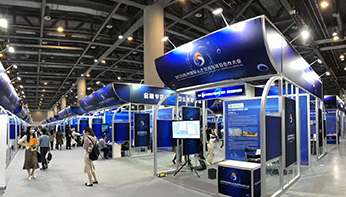People's Daily: Convention and Exhibition Economy Adds Vitality to Urban Development
People's Daily published an article focusing on the convention and exhibition industry in its seventh edition, highly affirming the role and value of the convention and exhibition economy on Sept.4.
The following is the article:
Convention and Exhibition Economy Adds Vitality to Urban Development
All over the world, some cities take advantage of their own location or industrial advantages to build international convention and exhibition brands, which not only promote economic and trade exchanges and economic growth but also develop into an important window to display the images of the country and the city. In the process of the development of convention and exhibition economics, the government, enterprises, and industry associations have made a rational division of labor, formed joint forces, and have made intensive efforts in marketization, specialization, and internationalization, and harvested good economic and social benefits.
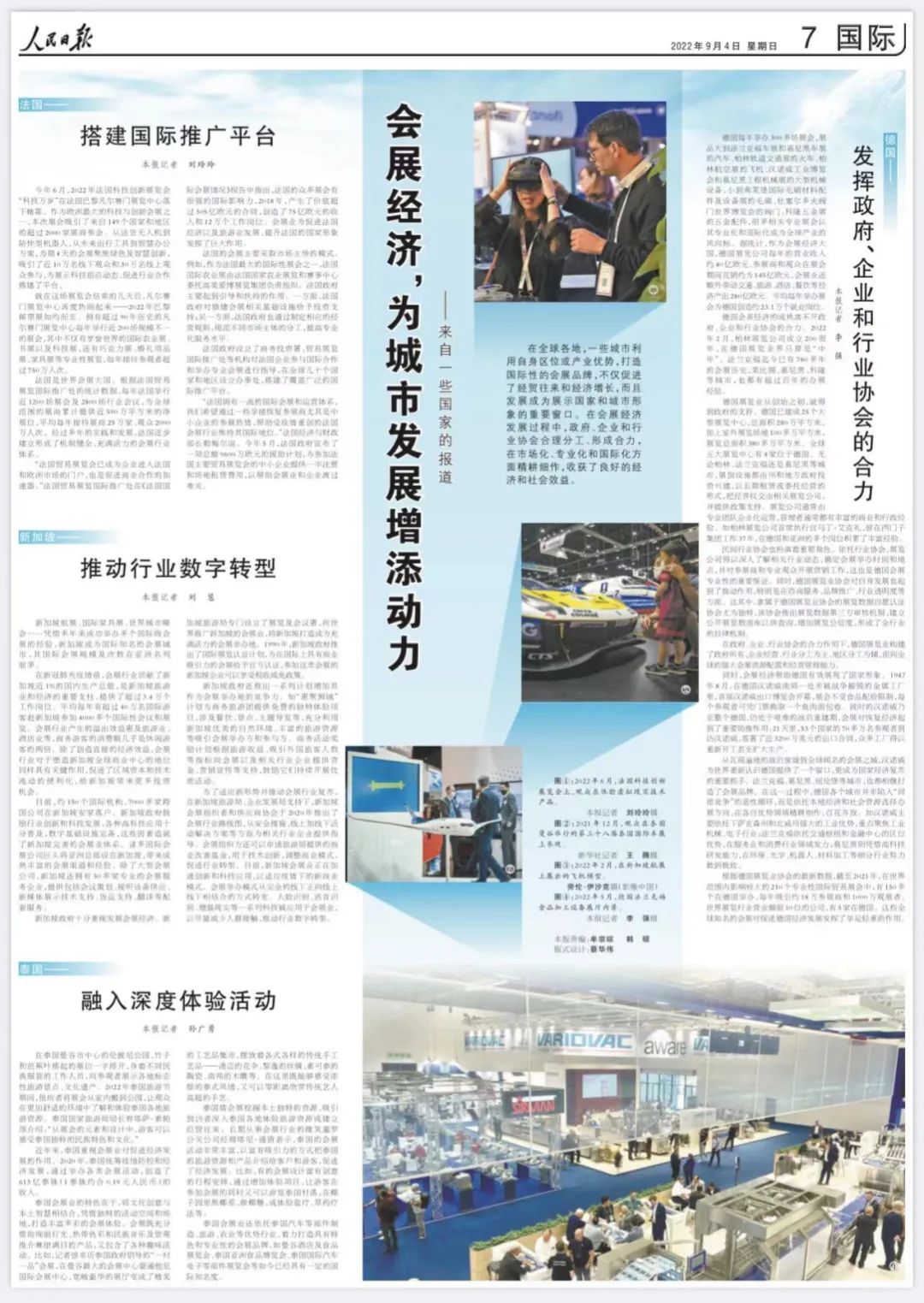
Germany: Bringing together government, business, and industry associations
Germany holds more than 300 exhibitions every year, with exhibits ranging from cars at the Frankfurt Motor Show and Munich Motor Show, trains at the Berlin Rail Transit Show, airplanes at the Berlin Air Show, large machinery and equipment at the Hannover Messe and the Munich Construction Machinery Show, to the accessories of the International Brush Material and brushes of Equipment Show, the valves of the Valve World Expo in Dusseldorf, the hardware accessories of the Cologne Hardware Exhibition, many related professional exhibitions have become the vane of the global industry with their specialization and internationalization. According to statistics, as a major country in the exhibition industry, the annual operating income of German exhibition companies is about 4 billion euros, and the exhibitors and visitors spend about 14.5 billion euros during the exhibition. The exhibition industry also drives an additional 28 billion euros in economic output such as transportation, tourism, hotels, catering, and other industries. On average, exhibitions in Germany create about 231,000 jobs every year.
The maturity of the German exhibition economy is inseparable from the joint efforts of the government, enterprises, and industry associations. In February 2022, Germany Berlin Exhibition Limited celebrated its 200th anniversary, and it is only "middle-aged" in the German exhibition industry. Frankfurt has more than 780 years of exhibition history. Leipzig, Munich, Cologne, and other cities also have more than 100 years of exhibition experience.
The German exhibition industry has been supported by the government since its inception. Germany has built 25 large exhibition centers with a total area of 2.8 million square meters, and more than 1 million square meters of outdoor exhibition venues, the total exhibition area is more than 3.8 million square meters. Four of the world's five largest exhibition centers are located in Germany. Regardless of cities such as Berlin, Frankfurt, or Munich, the exhibition hall facilities are invested in and constructed by state and local governments. In the form of a long-term lease or entrustment operation, the management rights are handed over to the relevant exhibition companies, and the government provides policy support. Exhibition companies are usually run by professional teams, and managers usually have extensive commercial and administrative experience. For example, Martin Ackerley, CEO of Germany Berlin Exhibition Limited, has worked in Siemens Group for 37 years and has accumulated rich experience in many positions in Germany and Asia.
Private industry associations also play an important role. Relying on industry associations, exhibition companies can deeply understand relevant industry trends, determine the time and location of exhibitions, and carry out marketing work for exhibitors and professional visitors, which is also an important guarantee for the professionalism of German exhibitions. At the same time, the German Exhibition Industry Association has also played a role in promoting its own development, especially in terms of consulting services, brand promotion, and industry transparency. Among them, the Society for Voluntary Control of Exhibition Statistics, which is a member of the German Exhibition Industry Association, is particularly unique. The association launched a third-party audit mechanism for exhibition data, established a public exhibition database for inquiry, increased the credibility of the exhibition, and formed a self-discipline mechanism in the whole industry.
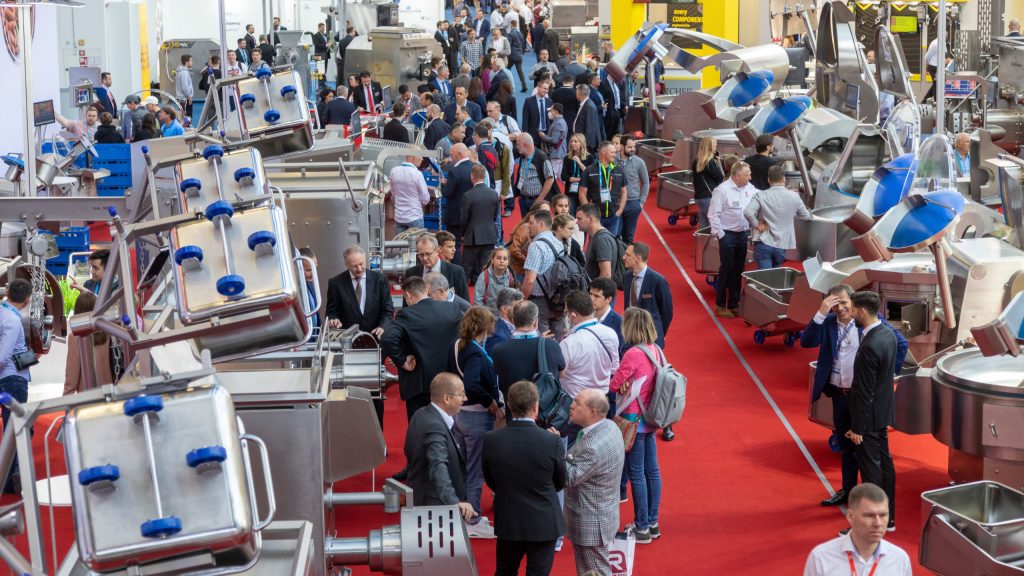
Food processing equipment exhibition hall in Frankfurt in May 2022 (Photo: from the internet)
Under the joint efforts of the government, enterprises, and industry associations, the German exhibition industry has built a strong global-oriented exhibition resource allocation and management capability, which is owned by the government, operated by enterprises, and divided into industries.
At the same time, the exhibition economy has helped Germany effectively present its national image. In August 1947, in a metal factory in the southern suburbs of Hannover, which was not destroyed by the war, the first Hannover Export Fair opened. The exhibition was not restricted by food rationing and each visitor could exchange a ticket for a fish roll. At that time, Hannover and even Germany as a whole were still in a difficult period of post-war reconstruction. The exhibition played an important role in boosting the recovery of the economy: in 21 days, more than 700,000 visitors from 53 countries visited Hannover and signed nearly 32 million US dollars in export contracts, allowing many factories to reopen and even expand production.
From the rubble-covered post-war ruins to the world-famous exhibition city, Hannover has provided a window for the world to re-understand Germany and has become an important starting point for the country's economic recovery. Frankfurt, Munich, Nuremberg, and other cities have also created exhibition brands one after another. During this process, cities in Germany did not fall into a vicious circle of "homogeneous competition", but chose the direction of exhibitions based on local economic and social resources, and cultivated in their respective advantageous fields. For example, Hannover mainly relies on the strong industrial advantages of Lower Saxony and North Rhine-Westphalia, focusing on industrial machinery and electronics. Frankfurt relies on the geographical advantages of the transportation hubs and financial centers to make efforts in the service industry and consumer industry. Munich, relying on high-tech research and development capabilities, strives to achieve the ultimate in sub-sectors such as environmental protection, optics, robotics, and material processing.
According to the latest data from the German Exhibition Industry Association, as of 2021, more than 150 of the 210 professional international trade fairs with great influence around the world will be held in Germany, attracting about 180,000 exhibitors and 10 million visitors every year. Five of the top 10 companies in the world exhibition industry by turnover are in Germany. These world-renowned exhibitions have played a pivotal role in promoting German economic development.
Singapore: Driving industry digital transformation
Singapore Airshow, International Furniture Fair, World City Summit... With years of experience in successfully holding several international exhibitions, Singapore has become an internationally renowned exhibition city, and its scale and number of international exhibitions are among the best in Asia.
Before the COVID-19 pandemic, the convention and exhibition industry contributed nearly 1% of Singapore's GDP and was an important pillar of Singapore's tourism and economy, providing more than 34,000 jobs. On average, more than 400,000 international tourists visit Singapore each year to participate in more than 4,000 international conferences and exhibitions. The spillover benefits from the convention and exhibition industry benefit tourism, hospitality, and so on. Business tourists spend almost twice as much as leisure tourists. In addition to creating direct economic benefits, the exhibition industry also plays a key role in shaping Singapore's position as a global business center, facilitating the flow of regional capital and technology, and bringing more investment opportunities to Singapore.
At present, about 150 international institutions and more than 7,000 multinational companies have settled in Singapore. The Singapore government encourages industry innovation and technological development, various high-tech applications are very popular, and the digital infrastructure is complete. These factors have contributed to Singapore's exhibition industry system. Many international convention and exhibition company giants have their Asian headquarters in Singapore, bringing mature and rich exhibition channels and experience. In addition to large exhibition companies, Singapore also has more than 50 professional exhibition service companies, providing conference planning, audio-visual equipment supply, new media display technical support, freight support, translation, and other supporting services.
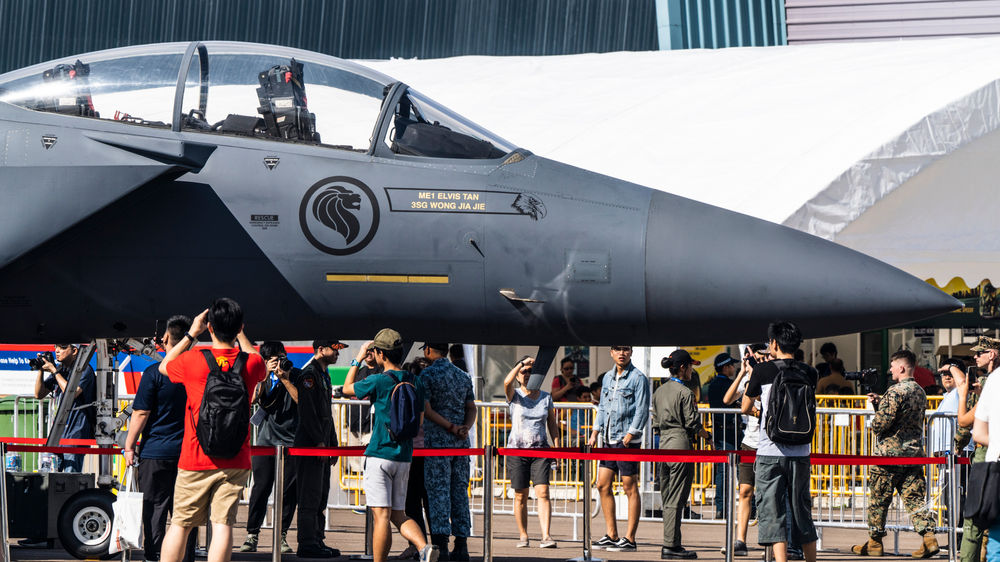
An aircraft model was on display at the Singapore Airshow in February 2022. (Photo: from the internet)
The Singapore government attaches great importance to the development of the exhibition economy. The Singapore Tourism Board has set up an Exhibition and Convention Department to promote Singapore's convention and exhibition industry to the world and build Singapore into a vibrant convention and exhibition venue. In 1990, the Singapore government launched the International Exhibition Certification Scheme to give official certification for internationally commercially attractive exhibitions. Singaporean enterprises participating in such exhibitions can enjoy tax relief policies.
The Singapore government has also launched a series of plans to increase its competitiveness as a convention and exhibition venue. For example, the "Benefiting Lion City" plan provides business tour groups with free and unique experience projects, involving catering, attractions, themed tours, and so on, making full use of Singapore's beautiful natural environment and rich tourism resources to attract exhibition organizers and participants. The Business Activity Rewards Program provides financial and marketing support to the convention and exhibition industry and related industries based on indicators such as tourism revenue and the number of attracted foreign tourists, to encourage them to continue to carry out high-quality activities.
In order to adapt to the new situation and promote the recovery of the convention and exhibition industry, with the support of the Singapore Tourism Board and Enterprise Singapore, the Singapore Convention and Exhibition Organisers and Suppliers Association launched the convention and exhibition industry roadmap in 2020, to provide guidance for related industries and enterprises in terms of safety measures, online and offline activities programs, and other aspects. Organizers can also apply for a business improvement fund provided by the Tourism Bureau for technological innovation, adjustment of business models, and promotion of industry transformation. At present, the Singapore convention and exhibition industry is accelerating innovation and technology application to adapt to the new business model under the epidemic. The mode of holding conventions and exhibitions has changed from completely offline to a combination of online and offline. A series of technologies such as face recognition, voice recognition, and augmented reality are applied to the convention and exhibition industry to minimize crowd contact and promote the digital transformation of the industry.
France: Build an international promotion platform
In June this year, the 2022 French Science and Technology Innovation Exhibition "Viva Tech" came to an end at the Porte de Versailles Exhibition Center in Paris, France. As one of the largest technology and innovation exhibitions in Europe, this exhibition attracted more than 2,000 exhibitors from 149 countries and regions. From delivery drones to companion robots, from future travel tools to smart office solutions, the four-day exhibition focused on green and smart innovation, attracting nearly 100,000 offline visitors and 300,000 online visitors. It has built a platform to display the latest trends in science and technology and promote industry cooperation.
Just a few days after the exhibition ended, the Porte de Versailles Exhibition Center was lively again - the 2022 Paris Stamp Exhibition came. With a history of more than 90 years, the Porte de Versailles Exhibition Center holds nearly 200 exhibitions of different scales every year, including not only the world-renowned international agricultural exhibition, book exhibition, and technology exhibition, but also professional exhibitions such as the chocolate exhibition, wedding supplies exhibition, furniture exhibition and so on. The exhibition center receives more than 7.5 million visitors every year.

French Technology Innovation Exhibition in June 2022. (Photo: from the internet)
France is the world's largest exhibition country. According to the statistics of the French Trade Exhibition International Promotion Office, nearly 1,200 exhibitions and 2,800 industry conferences are held in France every year, providing a total of nearly 5.9 million square meters of net booths for exhibitors worldwide, with an average of 250,000 exhibitors and 2,000 visitors each year. After years of practice and development, France has gradually established a well-established and dynamic exhibition industry system.
"French trade exhibitions have become a gateway for companies to enter the French and European markets, and also an accelerator to promote business cooperation." The French Trade Exhibition International Promotion Office pointed out in the report "France International Exhibition Situation" that many exhibitions in France have a strong international influence. In 2018, generated more than 30.5 billion euros worth of contracts, generating 7.5 billion euros in revenue and 120,000 jobs. The exhibition industry has played a huge role in promoting the development of the French economy and tourism and enhancing the national image of France.
The French exhibition mainly adopts a market-led model. For example, as one of the largest international exhibitions in France, French National Agricultural Exhibition and Competition Center entrusts COMEXPOSIUM to organize the French International Agricultural Exhibition, the French government mainly plays the role of guidance and support. On the one hand, the French government provides investment support for the construction of exhibition-related infrastructure; on the other hand, the French government also regulates the division of labor between different market players and improves the level of professional services by formulating corresponding operating rules.
The French government has set up the Business Investment Agency, French Trade Exhibition International Promotion Office, and other institutions to guide French companies to participate in international cooperation and hold professional exhibitions, set up offices in dozens of countries and regions around the world, and build a wide-ranging platform for international promotion.
"France has a first-class international exhibition and operation system. We hope to take some measures to restore the enthusiasm of exhibitors, especially SMEs, to help the French exhibition industry maintain its international status, which has been hit hard by the pandemic." French Minister of Economy and Finance Le Maire said. In May of this year, the French government announced a total aid program of 96 million euros, providing half of the registration and venue rental fees for SMEs participating in major French trade exhibitions to help the exhibition industry and enterprises tide over the difficulties.
Thailand: Integrate into in-depth experience activities
In Lumpini Park in the center of Bangkok, Thailand, booths made of bamboo and banana leaves are lined up. Staff dressed in different ethnic costumes show visitors the iconic tourist attractions and cultural heritage of various places. During the 2022 Thailand Tourism Festival, the organizers will move the exhibition from indoors to parks, allowing the visitors to experience tourism resources across Thailand in a more comfortable environment. Yuthasak Suprasong, director of the National Tourism Administration of Thailand, said: "From the elements and design of the exhibition, tourists can experience the unique national characteristics and culture of Thailand."
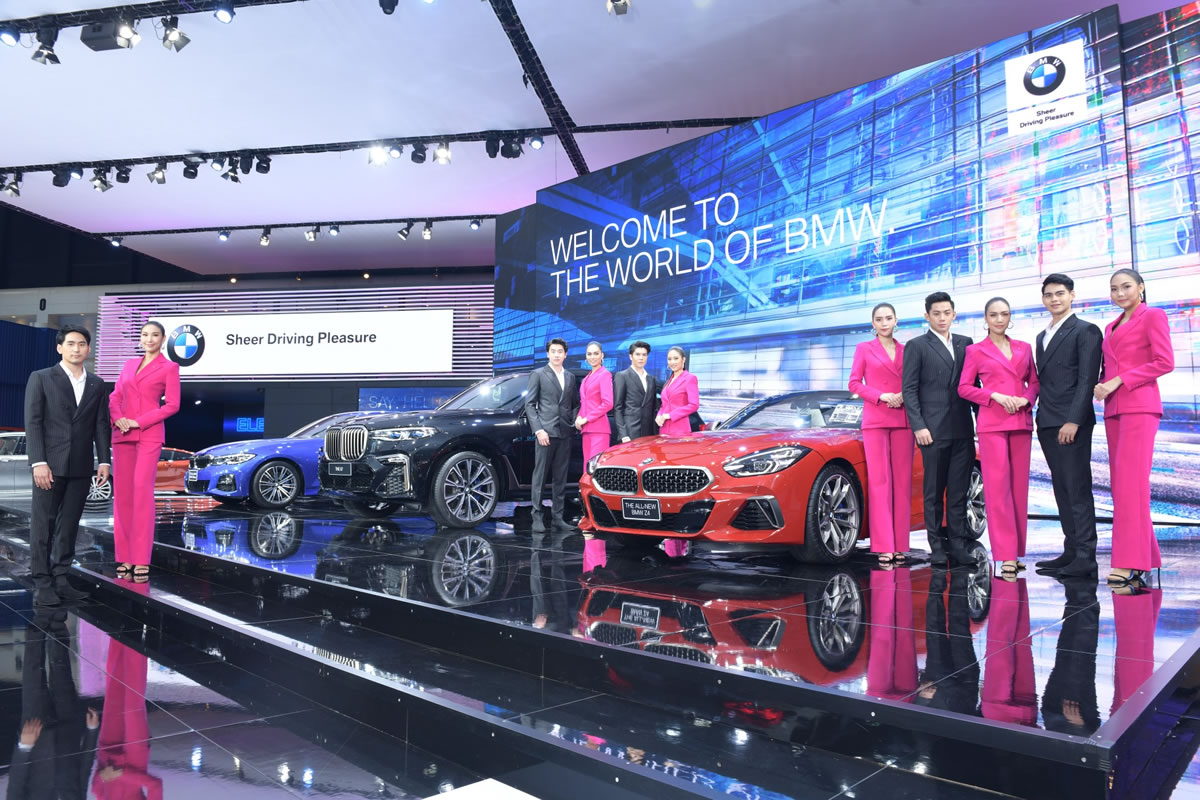
Visitors visit the 38th Thailand International Motor Show in Bangkok, Thailand, in December 2021. (Photo: from the internet)
In recent years, Thailand has attached great importance to the role of the convention and exhibition industry in promoting economic development. In 2020, Thailand coordinated epidemic prevention and control and economic development and created revenue of 61.3 billion baht (1 baht is about 0.19 yuan) by holding various exhibitions.
The characteristic of Thailand's exhibition industry is that it combines cultural creativity with local wisdom to create special exhibition experiences with unique event spaces and venues. The exhibition not only promotes a dazzling array of products with the help of gorgeous lights, tropical colors, ethnic music, and landscapes but also includes a variety of interesting activities. For example, the reporter has personally experienced the "One Village, One Product" exhibition advocated by the Thai government. At Bangkok's largest convention and exhibition center, Muang Thong Thani International Convention and Exhibition Center, the spacious and luxurious exhibition hall has turned into an exquisite handicraft market, with a variety of traditional handicrafts, such as the flower umbrella of Chiang Mai, the silk of Roi Et, the ceramics of Sukhothai, the wood carving of Lampang and so on. You can not only feel the strong Thai style but also appreciate the superb craftsmanship of traditional artists at zero distance here.
Thailand uses exhibitions to tap its unique local resources, attracting visitors to experience tourism resources or establishing economic and trade exchanges in various parts of Thailand. Tani Thongchai, manager of Smile Siam Public Relations Company, who has been engaged in the exhibition industry for a long time, said that Thailand's exhibition activities are very colorful, introducing Thailand's tourism resources and products to customers and tourists in an attractive way, and promoting economic development. For example, some exhibitions have creative itineraries, by adding experience items, visitors can visit Thai villages while participating in exhibitions, they could boil coconut milk, make coconut sugar in coconut gardens, or experience salt therapy, herbal therapy, and so on.
Thailand's convention and exhibition industry also relies on Thailand's advantageous industries such as auto parts manufacturing, tourism, and agriculture, and strives to create unique and professional exhibition brands, such as Bangkok Hotel and Food Expo, Thailand Asian Food Expo, and Thailand International Auto Electronic Components Exhibition, they have certain international reputations now.




 Sign in
Sign in CN
CN






